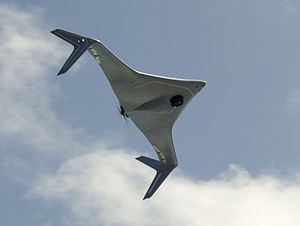
A | B | C | D | E | F | G | H | CH | I | J | K | L | M | N | O | P | Q | R | S | T | U | V | W | X | Y | Z | 0 | 1 | 2 | 3 | 4 | 5 | 6 | 7 | 8 | 9





An unmanned aerial vehicle (UAV), commonly known as a drone, is an aircraft without any human pilot, crew, or passengers on board. UAVs were originally developed through the twentieth century for military missions too "dull, dirty or dangerous"[1] for humans, and by the twenty-first, they had become essential assets to most militaries. As control technologies improved and costs fell, their use expanded to many non-military applications.[2] These include aerial photography, area coverage,[3] precision agriculture, forest fire monitoring,[4] river monitoring,[5][6] environmental monitoring,[7][8][9][10] policing and surveillance, infrastructure inspections, smuggling,[11] product deliveries, entertainment, and drone racing.
Terminology
Many terms are used for aircraft which fly without any persons on board.
The term drone has been used from the early days of aviation, some being applied to remotely flown target aircraft used for practice firing of a battleship's guns, such as the 1920s Fairey Queen and 1930s de Havilland Queen Bee. Later examples included the Airspeed Queen Wasp and Miles Queen Martinet, before ultimate replacement by the GAF Jindivik.[12] The term remains in common use. In addition to the software, autonomous drones also employ a host of advanced technologies that allow them to carry out their missions without human intervention, such as cloud computing, computer vision, artificial intelligence, machine learning, deep learning, and thermal sensors.[13] For recreational uses, an aerial photography drone is an aircraft that has first-person video, autonomous capabilities, or both.[14]
An unmanned aerial vehicle (UAV) is defined as a "powered, aerial vehicle that does not carry a human operator, uses aerodynamic forces to provide vehicle lift, can fly autonomously or be piloted remotely, can be expendable or recoverable, and can carry a lethal or nonlethal payload".[15] UAV is a term that is commonly applied to military use cases.[16] Missiles with warheads are generally not considered UAVs because the vehicle itself is a munition, but certain types of propeller-based missile are often called "kamikaze drones" by the public and media. Also, the relation of UAVs to remote controlled model aircraft is unclear,[citation needed] UAVs may or may not include remote-controlled model aircraft. Some jurisdictions base their definition on size or weight; however, the US FAA defines any uncrewed flying craft as a UAV regardless of size. [citation needed] A similar term is remotely piloted aerial vehicle (RPAV).
UAVs or RPAVs can also be seen as a component of an unmanned aircraft system (UAS), which also includes a ground-based controller and a system of communications with the aircraft.[4] The term UAS was adopted by the United States Department of Defense (DoD) and the United States Federal Aviation Administration (FAA) in 2005 according to their Unmanned Aircraft System Roadmap 2005–2030.[17] The International Civil Aviation Organization (ICAO) and the British Civil Aviation Authority adopted this term, also used in the European Union's Single European Sky (SES) Air Traffic Management (ATM) Research (SESAR Joint Undertaking) roadmap for 2020.[18] This term emphasizes the importance of elements other than the aircraft. It includes elements such as ground control stations, data links and other support equipment. Similar terms are unmanned aircraft vehicle system (UAVS) and remotely piloted aircraft system (RPAS).[19] Many similar terms are in use. Under new regulations which came into effect 1 June 2019, the term RPAS has been adopted by the Canadian Government to mean "a set of configurable elements consisting of a remotely piloted aircraft, its control station, the command and control links and any other system elements required during flight operation".[20]
Classification types
UAVs may be classified like any other aircraft, according to design configuration such as weight or engine type, maximum flight altitude, degree of operational autonomy, operational role, etc. According to the United States Department of Defense, UAVs are classified into five categories below:[21][22]
| Group: | Group 1 | Group 2 | Group 3 | Group 4 | Group 5 |
|---|---|---|---|---|---|
| Size | Small | Medium | Large | Larger | Largest |
| Max take-off wt | < 20 lb (9.1 kg) |
> 20 & < 55 | > 55 & < 1320 | >1,320 lb (600 kg) |
>1,320 lb (600 kg) |
| Operating altitude | < 1,200 ft (370 m) |
< 3,500 ft (1,100 m) |
< 18,000 ft (5,500 m) |
< 18,000 ft (5,500 m) |
> 18,000 ft (5,500 m) |
| Speed | < 100 kn (190 km/h) |
< 250 kn (460 km/h) |
< 250 kn (460 km/h) |
Any speed | Any speed |
Other classifications of UAVs include:[21]
Range and endurance
There are usually five categories when UAVs are classified by range and endurance:[21]
| Category: | Very close range UAVs | Close range UAVs | Short range UAVs | Medium range UAVs | Long range UAVs |
|---|---|---|---|---|---|
| Range (km): | < 5 | > 5 & < 50 | > 50 & < 150 | > 150 & < 650 | > 650 |
| Endurance (hr): | 0.5 – 0.75 | 1–6 | 8–12 | 12 – 36 or 48 | > 36 or 48 |
Size
There are usually four categories when UAVs are classified by size, with at least one of the dimensions (length or wingspan) meet the following respective limits:[21]
| Category: | Micro/Very small UAVs | Mini/Small UAVs | Medium UAVs | Large UAVs |
|---|---|---|---|---|
| Length/Wingspan: | < 50 cm | > 50 cm & < 2 m | 5 –10 m | > 10 m |
Weight
Based on their weight, drones can be classified into 5 categories—
